-
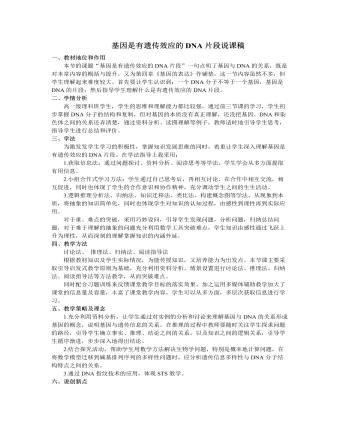
人教版高中生物必修2基因是有遗传效应的DNA片段说课稿
1.基因的化学组成:每个基因含有成百上千个脱氧核苷酸。讲述:基因的脱氧核苷酸排列顺序代表遗传信息。2.基因不同的实质:不同的基因,四种脱氧核苷酸的排列顺序不同,但是每个基因都有特定的排列顺序。3.基因的位置:染色体是基因的主要载体,每个染色体含有一个DNA分子,每个DNA分子含有多个基因,基因在染色体上呈直线排列。4.基因是有遗传效应的DNA片段这就是说,基因是DNA的片段,但必须具有遗传效应(指具有复制、转录、翻译、重组突变及调控等功能)。有的DNA片段属间隔区段,没有控制性状的作用,这样的DNA片段就不是基因。控制某种性状的基因有特定的DNA片段,蕴含特定的遗传信息,可以切除,可以拼接到其他生物的DNA上,从而获得某种性状的表达。例如:把牛的胰岛素基因拼接到大肠杆菌的DNA上,大肠杆菌可以生产胰岛素。

人教版高中地理必修2第三章第二节以种植业为主的农业地域类型说课稿
本节课标解读:1.说明以种植业为主的农业地域类型的形成条件及特点;2.说出商品谷物农业的分布范围,说明商品谷物农业的形成条件及特点。内容地位与作用:农业是受自然环境影响最大的产业。农业是发展历史最悠久的产业,随着社会的发展和进步,社会环境对农业的影响越来越大。以季风水田农业为主的农业地域类型,主要体现自然环境对农业地域形成的影响;商品谷物农业则体现了社会环境对农业地域形成的影响。本节内容包括两部分内容,一个是季风水田农业,主要分布在亚洲季风区;一个是商品谷物农业,主要分布在发达国家。教材文字内容不多,配备了大量的地图和景观图。因此,在教学过程中要充分组织学生查阅地图,挖掘地理信息,培养分析能力。分析农业区位因素时,必须从自然因素和社会经济因素两个方面去分析,找出优势区位因素来。
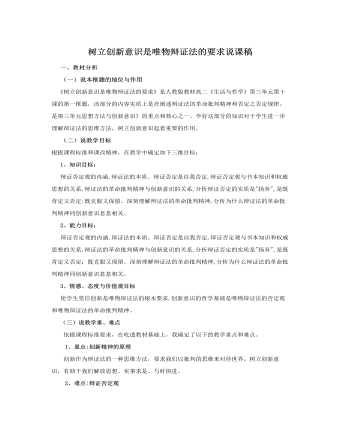
人教版高中政治必修4树立创新意识是唯物辩证法的要求说课稿(二)
一、教材分析(一)说本框题的地位与作用《树立创新意识是唯物辩证法的要求》是人教版教材高二《生活与哲学》第三单元第十课的第一框题,该部分的内容实质上是在阐述辩证法的革命批判精神和否定之否定规律。是第三单元思想方法与创新意识》的重点和核心之一。学好这部分的知识对于学生进一步理解辩证法的思维方法,树立创新意识起着重要的作用。(二)说教学目标根据课程标准和课改精神,在教学中确定如下三维目标:1、知识目标:辩证否定观的内涵,辩证法的本质。辩证否定是自我否定,辩证否定观与书本知识和权威思想的关系,辩证法的革命批判精神与创新意识的关系,分析辩证否定的实质是"扬弃",是既肯定又否定;既克服又保留。深刻理解辩证法的革命批判精神,分析为什么辩证法的革命批判精神同创新意识息息相关。
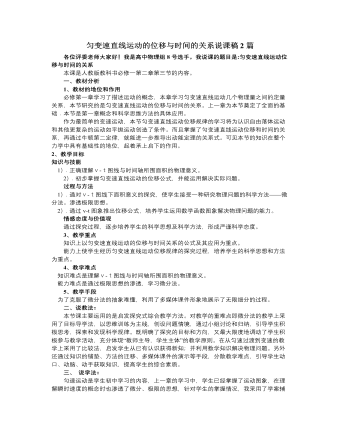
人教版新课标高中物理必修1匀变速直线运动的位移与时间的关系说课稿2篇
培养学生合作交流意识和探究问题的能力,这一部分知识层层递进,符合学生由特殊到一般、由简单到复杂的认知规律。4、互动探究(1)极限思想的渗透让学生阅读“思考与讨论”小版块.培养学生的自学和阅读能力提出下列问题,进行分组讨论:a、用课本上的方法估算位移,其结果比实际位移大还是小?为什么?b、为了提高估算的精确度,时间间隔小些好还是大些好?为什么?针对学生回答的多种可能性加以评价和进一步指导。让学生从讨论的结果中归纳得出:△t越小,对位移的估算就越精确。渗透极限的思想。通过小组内分工合作,讨论交流,培养学生交流合作的精神,以及搜集信息、处理信息的能力;通过小组间对比总结,使学生学会在对比中发现问题,在解决问题过程中提高个人能力;
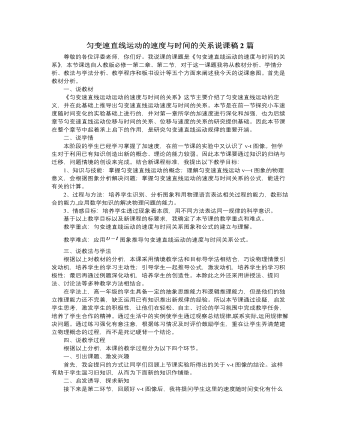
人教版新课标高中物理必修1匀变速直线运动的速度与时间的关系说课稿2篇
设计意图:几道例题及练习题,其中例1小车由静止启动开始行驶,以加速度 做匀加速运动,求2s后的速度大小?进而变式到:小车遇到红灯刹车……,充分体现了“从生活到物理,从物理到社会”的物理教学理念;例题及练习题由浅入深、由易到难、各有侧重,体现新课标提出的让不同的学生在物理上得到不同发展的教学理念。这一环节总的设计意图是反馈教学,内化知识。(6) 小结归纳,拓展深化我的理解是,小结归纳不应该仅仅是知识的简单罗列,而应该是优化认知结构,完善知识体系的一种有效手段,为充分发挥学生的主题作用,从学习的知识、方法、体验是那个方面进行归纳,我设计了这么三个问题:① 通过本节课的学习,你学会了哪些知识;② 通过本节课的学习,你最大的体验是什么;③ 通过本节课的学习,你掌握了哪些学习物理的方法?
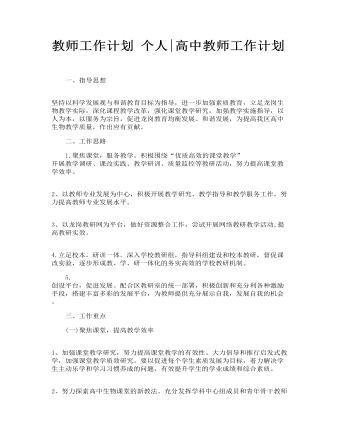
高中教师工作计划
1.聚焦课堂,服务教学。积极围绕“优质高效的课堂教学” 开展教学调研、课改实践、教学研训、质量监控等教研活动,努力提高课堂教学效率。 2、以教师专业发展为中心,积极开展教学研究、教学指导和教学服务工作,努力提高教师专业发展水平。 3、以龙岗教研网为平台,做好资源整合工作,尝试开展网络教研教学活动,提高教研实效。
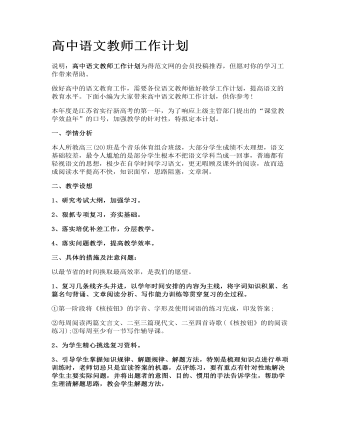
高中语文教师工作计划
二、教学设想1、研究考试大纲,加强学习。2、狠抓专项复习,夯实基础。3、落实培优补差工作,分层教学。4、落实问题教学,提高教学效率。
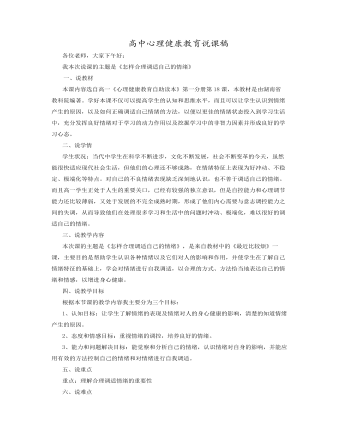
高中心理健康教育说课稿
二、说学情学生状况:当代中学生在科学不断进步,文化不断发展,社会不断变革的今天,虽然能很快适应现代社会生活,但他们的心理还不够成熟,在情绪特征上表现为好冲动、不稳定、极端化等特点。对自己的不良情绪表现缺乏深刻地认识,也不善于调适自己的情绪。而且高一学生正处于人生的重要关口,已经有较强的独立意识,但是自控能力和心理调节能力还比较薄弱,又处于发展的不完全成熟时期,形成了他们内心需要与意志调控能力之间的失调,从而导致他们在处理很多学习和生活中的问题时冲动、极端化,难以很好的调适自己的情绪。
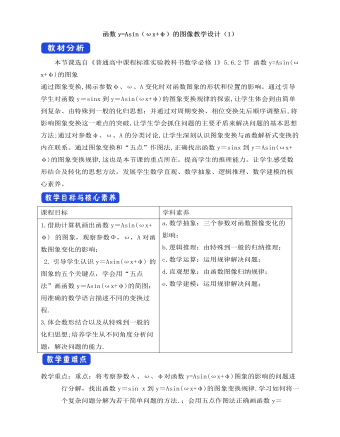
人教A版高中数学必修一函数y=Asin(ωχ+φ)教学设计(1)
本节课选自《普通高中课程标准实验教科书数学必修1》5.6.2节 函数y=Asin(ωx+φ)的图象通过图象变换,揭示参数φ、ω、A变化时对函数图象的形状和位置的影响。通过引导学生对函数y=sinx到y=Asin(ωx+φ)的图象变换规律的探索,让学生体会到由简单到复杂、由特殊到一般的化归思想;并通过对周期变换、相位变换先后顺序调整后,将影响图象变换这一难点的突破,让学生学会抓住问题的主要矛盾来解决问题的基本思想方法;通过对参数φ、ω、A的分类讨论,让学生深刻认识图象变换与函数解析式变换的内在联系。通过图象变换和“五点”作图法,正确找出函数y=sinx到y=Asin(ωx+φ)的图象变换规律,这也是本节课的重点所在。提高学生的推理能力。让学生感受数形结合及转化的思想方法。发展学生数学直观、数学抽象、逻辑推理、数学建模的核心素养。
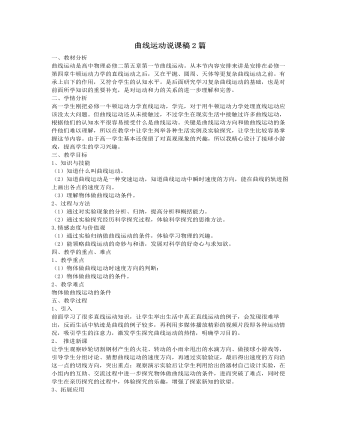
人教版新课标高中物理必修2曲线运动说课稿2篇
1、举例:2、结论:(1)物体的运动轨迹是曲线的运动叫曲线运动。(2)曲线运动中速度方向是时刻改变的。(二)、曲线运动方向:1、质点在某一点(或某一时刻)的速度的方向是在曲线的这一点的切线方向。2、曲线运动中速度方向是时刻改变的,因此曲线运动是变速运动。(三)、曲线运动条件:1、演示实验:2、结论:当物体所受的合力的方向跟它的速度方向不在同一直线时,物体就做曲线运动。七、课堂小结:1、运动轨迹是曲线的运动叫曲线运动。2、曲线运动中速度的方向是时刻改变的,质点在某一点的瞬时速度的方向在曲线的这一点的切线上。3、当合外力F的方向与它的速度方向有一夹角a时,物体做曲线运动。八、巩固训练:1、关于曲线运动,下列说法正确的是()。A:曲线运动一定是变速运动;B:曲线运动速度的方向不断的变化,但速度的大小可以不变;
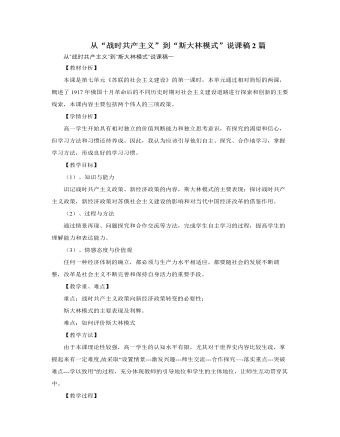
人教版高中历史必修2从“战时共产主义”到“斯大林模式”说课稿2篇
【课堂小结】本课主要讲述俄国十月革命后进行经济建设,并在建设中进行社会主义探索,期间先后出现了战时共产主义政策、新经济政策和斯大林模式,这些政策和体制的产生都是历史和当时现实有关,但也反映出在建设社会主义中既有成功的也由重大失误,主要在于缺乏现成的政策和模式可供借鉴,更在于理论上的缺乏。斯大林模式的形成同苏联当时社会生产力的发展水平相适应,它在初期和战争时期曾发挥了巨大作用,使苏联成为强大的社会主义国家。它建立的高度集中的计划经济体制和新型的工业化模式是苏联进行社会主义建设中的探索和创新,对二战后社会主义国家产生了深刻影响,促进这些国家国民经济的恢复和发展,形成了足以同资本主义相抗衡的社会主义阵营。但是,它没有解决社会主义民主政治建设和经济运行的一系列根本问题,违背了列宁关于把文化经济建设当作工作重心的指示,仍把政治斗争放在第一位。
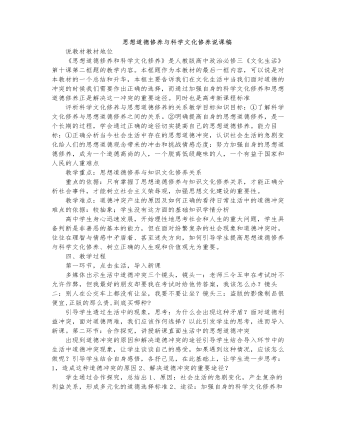
人教版高中政治必修3思想道德修养与科学文化修养说课稿
由此引导学生的深思,学生通过合作探究,帮助学生认识到不注重思想道德修养,即使掌握了丰富的科学知识,也难以避免人格上的缺失,甚至危害社会。进而总结出关系二:加强思想道德修养,能够促进科学文化修养。科学文化修养的意义播放感动中国人物徐本禹先进事迹短片。学生观看完视频后,思考:从徐本禹的事迹中,我们可以了解到我们加强科学文化修养的根本意义是什么?引导学生结合自身体会,发表各自见解,在此基础上帮助学生总结出,要使自己的思想道德境界不断升华,为人民服务的本领不断提高,成为一个真正有知识文化涵养的人,成为一个脱离低级趣味的人、有益于人民的人。知识点三:追求更高的思想道德目标根据教材110探究活动(思想道德的差异、反应人们世界观、人生观、价值观的差异)思考:用公民的基本道德规范来衡量这些观点,你赞成哪些观点?反对哪些观点?小组进行合作探究,引导学生根据公民基本道德规范对这些价值观进行评析。
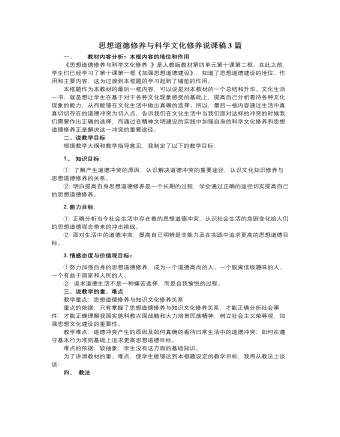
人教版高中政治必修3思想道德修养与科学文化修养说课稿3篇
(3)改造主观世界同改造客观世界的关系。改造客观世界同改造主观世界,是相互联系、相互作用的。改造主观世界是为了更好地改造客观世界,人们在改造客观世界的同时也改造着自己的主观世界。通过自觉改造主观世界,又能提高改造客观世界的能力。师:人们对自己的思想道德境界的追求,是永远止境的。让我们共同努力,在践行社会主义思想道德的过程中,不断追求更高的目标,像无数先辈那样,加入到为共产主义远大理想而奋斗的行列中吧!课堂小结通过本节课学习使我们认识到面对现实生活中的思想道德冲突,加强知识文化修养和思想道德修养,不断追求更高的思想道德目标的必要性;把握了知识文化修养与思想道德修养的含义及其相互关系;明确了我们应该和怎样追求更高的思想道德目标;认识到这是一个永无止境的过程。我们要脚踏实地,从现在做起、从点滴小事做起,不断提高知识文化修养和思想道德修养,追求更高的思想道德目标。

新人教版高中英语必修3Unit 1 Festivals and celebrations-Discovering Useful Structure教学设计
4.That was an experience that frightened everyone. →That was _____________________. 答案:1. taking 2. being discussed 3. in the reading room 4. a frightening experienceStep 6 The meaning and function of V-ing as the predicative动词-ing形式作表语,它通常位于系动词后面,用以说明主语“是什么”或“怎么样”一种表示主语的特质、特征和状态, 其作用相当于形容词; 另一种具体说明主语的内容, 即主语等同于表语, 两者可互换。The music they are playing sounds so exciting. 他们演奏的音乐听起来令人激动。The result is disappointing. 结果令人失望。Our job is playing all kinds of music. 我们的工作就是演奏各种音乐。Seeing is believing. 眼见为实。Step 7 Practice1. It is ________(amaze) that the boy is able to solve the problem so quickly.2. Buying a car is simply _______(waste) money. 3. Please stop making the noise—it’s getting ________(annoy). 4. complete the passage with the appropriate -ing form.La Tomatina is a festival that takes place in the Spanish town Bunol every August. I think many food festivals are __________ because people are just eating. however, this festival is _________ because people don't actually eat the tomatoes. Instead, they throw them at each other! the number of people ________ part in this tomato fight, can reach up to 20,000, and it is a very __________ fight that lasts for a whole hour. The _______ thing is how clean Bunol is after the tomatoes are washed away after the fight. this is because the juice form tomatoes is really good for making surfaces clean!答案:1. amazing 2. wasting 3. annoying4. boring interesting taking exciting amazing

新人教版高中英语必修3Unit 1 Festivals and Celebrations-Reading and Thinking教学设计
The topic of this part is “Discover the reasons for festivals and celebrations.The Listening & Speaking & Talking part aims at talking about the experiences and feelings or emotions about the festivals and celebrations. This section aims at detecting the reason why the people celebrate the festivals, the time, the places, the types and the way of celebrations. It also explains why some traditions in the old celebrations are disappearing, like the firecrackers in the big cities and some new things are appearing like the prosperity of business or commerce. 1. Students can talk about what festivals they know and the reasons and the way of celebrating them.2. Students should learn the reading skills such as the headline and get the topic sentences, the structures of articles.3. Students can understand the past, the present situation of some festival around the world and why there are some changes about them. 4. Students can have the international awareness about the festivals.1. Students should learn the reading skills such as the headline and get the topic sentences, the structures of articles.2. Students can understand the past, the present situation of some festival around the world and why there are some changes about them.Step 1 Lead in---Small talkWhat festival do you like best ? Why ?I like the Spring Festivals because I can set off the fireworks, receive the lucky money and enjoy the Gala with my families.Step 2 Before reading---Pair workWhy do people celebrate different festivals ?The Spring Festivals is to celebrate the end of winter and the coming of spring and new life.The Mid-autumn Day is to celebrate the harvest and admire the moon.

新人教版高中英语必修3Unit 1 Festivals and Celebrations-Listening &Speaking&Talking教学设计
The theme of this section is “Talk about festival activities and festival experiences”.Festival and holiday is a relaxing and interesting topic for students. This part talks about the topic from the daily life of students’. In the part A ---Listening and Speaking, there are three conversations among different speakers from three countries(Japan, Rio and China), where the speakers are participating in or going to participate in the festivals and celebrations. So listening for the relationship among them is a fundamental task. Actually, with the globalization and more international communication, it is normal for Chinese or foreigners to witness different festivals and celebrations in or out of China. In the Conversation 1, a foreign reporter is interviewing a Japanese young girl who just had participated in the ceremony of the Coming-of-Age Day on the street and asking her feeling about the ceremony and the afterwards activities. Conversation 2, Chinese girl Li Mei is witnessing the Rio Carnival for the first time, and her friend Carla gives her some advice on the costumes which enables her to match with the carnival to have a good time. Conversation 3, a Chinese guide is showing a group of foreign visitors around the Lantern Festival and introducing the customs of the festival to them. The three conversations have a strong vitality and insert the festival and cultural elements from different countries. So perceiving the festivals and cultures from different countries is the second task. At the same time, the scripts also insert the targeted grammar --- v-ing as attributive and predicative, which students can perceive and experience in a real context and make a road for the further study. That is the third task. In the Part B--- Listening and Talking, the theme is “Talk about festival experience”, which is the common topic in our daily conversations. During the conversation, Song Lin, a Chinese student, asked Canadian friend Max about how to spend Christmas. In the conversation, Song Lin talked about experience and the feelings during the Chinese Spring Festival, during which there are not only some enjoyable things but some unpleasant things. After the listening, perhaps students find there are some similarities between Christmas and the Chinese Spring Festival as there are some differences in the origins and celebrations. For example, people always visit friends and relatives, decorate their houses, have a big dinner together, chat and give presents to each other.

新人教版高中英语必修3Unit 1 Festivals and Celebrations-Reading for Writing教学设计一
The topic of this part is “Write about your festival experience”.During the Listening and Speaking and Talking, students are just asked to say out their festival experiences such as the Spring Festival, Mid-autumn Day, but this part students will be asked to write down their own festival experiences. During the reading part, it introduces the Naadam Festival in Inner Mongolia Autonomous Region, which can give students a good example to imitate. Students not only learn the festival, but touch and feel the Inner Mongolian’s character, the spirit and cultural atmosphere, which can help students form the cultural awareness and learn to enjoy and value the diversity of Chinese culture.Concretely, the dairy tells the experience that the author spent the Naadam Festival in Inner Mongolia Autonomous Region with his/her friend. The structure is clear. In the opening paragraph, it introduces the topic of the Naadam Festival and the whole feeling. Then it introduces the items of the festival like the ceremony, wrestling and horse racing. Finally, it summarizes this experience. Because this part is a travel journal, we must guide students pay more attention to these details: 1. use the first person. 2. use the past tense to tell the past thing and use the present or future tense to describe the scenery. 3. use the timeline to tell the development. 4. be careful for the author’s psychology, emotion and feeling, etc.1. Read quickly to get main idea; read carefully to get the detailed information about Naadam Festival.2. Learn the structure of the reading article and language.3. Write an article about a festival experience4. Learn to use the psychology, emotions and feeling in the writing.1. Write an article about a festival experience.2. Use the structure of the reading article and language.

新人教版高中英语必修3Unit 2 Morals and Virtues-Discovering Useful Structure教学设计
1. 表示时间。Hearing these stories, I’m skeptical about the place. = When I heard these stories. . . 2. 表示原因。Not knowing his address, I can’t send this book to him. = Because/Since/As I don’t know his address. . . 3. 表示结果。His father died, leaving him a lot of money. =. . . and left him a lot of money4. 表示条件。Going straight down the road, you will find the department store. = If you go straight down the road. . . 5. 表示让步。Being tired, they went on working. =Although they were tired. . . 6. 表示行为方式、伴随情况或补充说明。He lay on the grass, staring at the sky for a long time. =. . . and stared at the sky for a long time注意:非谓语动词作状语时, 如所提供的动词不能和句子中的主语保持一致, 动词-ing形式必须有自己的逻辑主语, 通常由名词或代词来担任, 这就是独立主格结构。The last bus having gone, we had to walk home. (having gone的逻辑主语是the last bus, 而不是we)Weather permitting, the football match will be played on Friday. (permitting的逻辑主语是time, 而不是the football match)Step 7 Practice1. ________(study) hard, you are sure to get first prize. 2. People use plastic in their daily life, _______(leave) large amounts of waste. 3. ________(work) hard at your lessons, you are to succeed. 4. The old man, ____________(work) abroad for twenty years, is on the way back to his motherland. 5. ______________(finish) his homework, he was playing on the playground. Answers: 1. Studying 2. leaving 3. Working 4.having worked 5. Having finishedStep 8 HomeworkFinish the homework on Page 22.
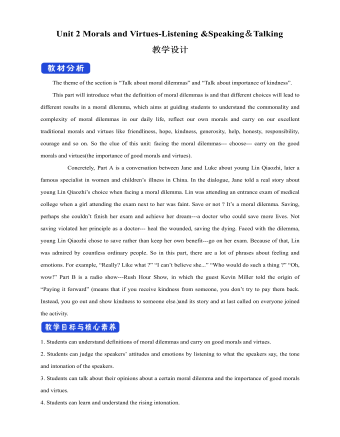
新人教版高中英语必修3Unit 2 Morals and Virtues-Listening &Speaking&Talking教学设计
Example:One day, a poor boy who was trying to pay his way through school by sending newspapers door to door found that he only had one dime(一角)left. He was so hungry that he decided to beg for a meal at the next house.However, he lost his nerve when a lovely young woman opened the door. Instead of a meal he asked for a drink of water. She thought he looked hungry so she brought him a large glass of milk. He drank it slowly, and then asked, “How much do I owe you?” “You don’t owe me anything,” she replied, “Mother has taught me never to accept pay for a kindness.” “Then I thank you from the bottom of my heart.” With these words, Howard Kelly left that house.Years later the woman became badly ill and was finally sent to the hospital in a big city. Dr. Howard Kelly, now famous, was called in. When he heard the name of the town she came from, a strange light filled his eyes. Dressed in his doctor’s clothes, Dr. Kelly went into her room and recognized her at once. From that day on, he gave special attention to her, and decided to do his best to save her life.At last the woman was saved. Dr. Kelly asked the business office to pass the final bill to him. He looked at it and then wrote something on the side. The bill was sent to the woman’s room. She was afraid to open it because she was sure that it would take the rest of her life to pay for it off. Finally she looked, and the note on the side of the bill caught her attention. She read these words: “Paid in full with a glass of milk, Dr. Howard Kelly.” Tear of joy flooded her eyes.
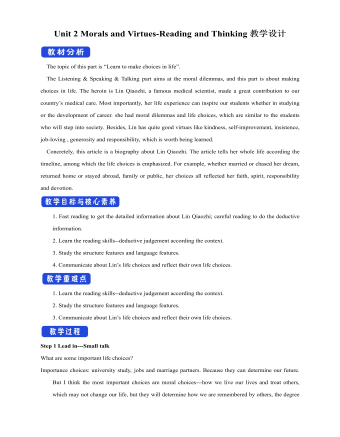
新人教版高中英语必修3Unit 2 Morals and Virtues-Reading and Thinking教学设计
The topic of this part is “Learn to make choices in life”.The Listening & Speaking & Talking part aims at the moral dilemmas, and this part is about making choices in life. The heroin is Lin Qiaozhi, a famous medical scientist, made a great contribution to our country’s medical care. Most importantly, her life experience can inspire our students whether in studying or the development of career. she had moral dilemmas and life choices, which are similar to the students who will step into society. Besides, Lin has quite good virtues like kindness, self-improvement, insistence, job-loving , generosity and responsibility, which is worth being learned.Concretely, this article is a biography about Lin Qiaozhi. The article tells her whole life according the timeline, among which the life choices is emphasized. For example, whether married or chased her dream, returned home or stayed abroad, family or public, her choices all reflected her faith, spirit, responsibility and devotion.1. Fast reading to get the detailed information about Lin Qiaozhi; careful reading to do the deductive information.2. Learn the reading skills--deductive judgement according the context.3. Study the structure features and language features. 4. Communicate about Lin’s life choices and reflect their own life choices.1. Learn the reading skills--deductive judgement according the context.2. Study the structure features and language features.3. Communicate about Lin’s life choices and reflect their own life choices.Step 1 Lead in---Small talkWhat are some important life choices?Importance choices: university study, jobs and marriage partners. Because they can determine our future.